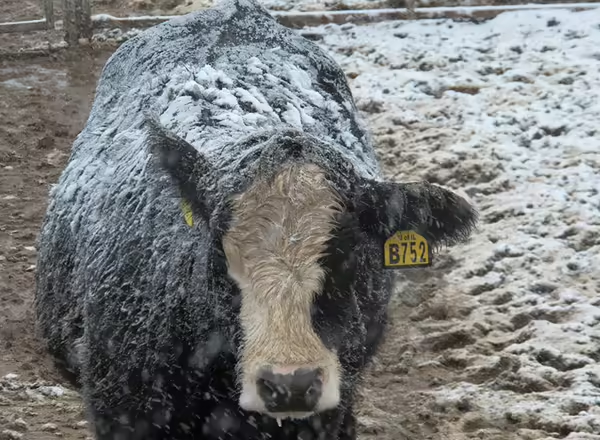
Cold Weather Management
What is cold weather to a cow?
When do cows feel the cold? There are three big factors to consider when determining what constitutes "cold" for a cow: temperature, wind speed, and heaviness of winter hair coat.
Hair coats make all the difference to surviving the weather.
Colder temperatures, higher wind speeds, and lighter hair coats will increase maintenance requirements.
- With a good winter coat, cattle will perform normally until temperatures drop below freezing (32°F), assuming no wind.
- If cattle have a heavy winter hair coat they can withstand temperatures as low as 19°F, again with no wind.
- When temperatures drop farther or wind chill is factored in, energy requirements increase approximately 1% for each degree. An easy way to get a ballpark figure on wind chill is to take the temperature and subtract the wind speed. So if it is 5°F with a wind speed of 10 mph, then the wind chill index is close to -5°F.

Weather is predictably unpredictable.
In early October, we saw a flash blizzard kill cows in parts of South Dakota. Much of the blame can be directed to the lack of a winter hair coat to help protect the cows from extreme conditions. Cattle with a summer hair coat or a hair coat that is wet have a lower critical temperature of only 59°F.
Cold following a rain is just as bad for us in the Midwest. Wet hair coats provide virtually no protection from wind and cold. This results in onset of cold stress at much higher temperatures. An area to allow cows to get out winter rain, sleet, and wind will also reduce cold stress.
If facilities are not available, cows use more energy to help cope with the cold.
Cows in good BCS can use body reserves to accomplish this if the cold stress is isolated and not a continuous event.
In longer periods of winter weather, additional energy may need to be supplied in the ration. For example, a temperature of 10°F with a wind speed of 20 mph will result in a 30% increase in requirement for a cow that has a heavy, dry hair coat. If that cow weighs 1,400 pounds then she will require an additional 4.5 lbs of TDN in late gestation and and additional 6.2 lbs. TDN in lactation. This results in the need for 6 lbs. and 9 lbs. of corn or Corn Gluten Feed (CGF).
We do not recommend feeding these levels of corn to cows. Use CGF, soyhulls, or DDGS as they will not cause a reduction in fiber digestion. It is wise to watch forecasts and plan for the colder weather. Do not vary rations greatly from day to day.
Recap for cold weather management for cattle
Cattle are hardy critters and can handle some adverse weather conditions. We, as caretakers, must be aware of the increased requirements cold stress can induce. Supplying windbreaks, covered housing, and additional energy in the ration all will help cattle come through winter in good condition and allow timely breed back in the spring.
About the author
